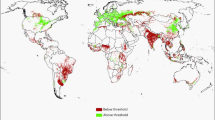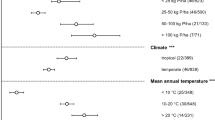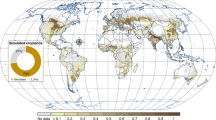Abstract
Agricultural intensification in the tropics is one way to meet rising global food demand in coming decades1,2. Although this strategy can potentially spare land from conversion to agriculture3, it relies on large material inputs. Here we quantify one such material cost, the phosphorus fertilizer required to intensify global crop production atop phosphorus-fixing soils and achieve yields similar to productive temperate agriculture. Phosphorus-fixing soils occur mainly in the tropics, and render added phosphorus less available to crops4,5. We estimate that intensification of the 8–12% of global croplands overlying phosphorus-fixing soils in 2005 would require 1–4 Tg P yr–1 to overcome phosphorus fixation, equivalent to 8–25% of global inorganic phosphorus fertilizer consumption that year. This imposed phosphorus ‘tax’ is in addition to phosphorus added to soils and subsequently harvested in crops, and doubles (2–7 Tg P yr–1) for scenarios of cropland extent in 20506. Our estimates are informed by local-, state- and national-scale investigations in Brazil, where, more than any other tropical country, low-yielding agriculture has been replaced by intensive production. In the 11 major Brazilian agricultural states, the surplus of added inorganic fertilizer phosphorus retained by soils post harvest is strongly correlated with the fraction of cropland overlying phosphorus-fixing soils (r2 = 0.84, p < 0.001). Our interviews with 49 farmers in the Brazilian state of Mato Grosso, which produces 8% of the world's soybeans mostly on phosphorus-fixing soils, suggest this phosphorus surplus is required even after three decades of high phosphorus inputs. Our findings in Brazil highlight the need for better understanding of long-term soil phosphorus fixation elsewhere in the tropics. Strategies beyond liming, which is currently widespread in Brazil, are needed to reduce phosphorus retention by phosphorus-fixing soils to better manage the Earth's finite phosphate rock supplies and move towards more sustainable agricultural production.
This is a preview of subscription content, access via your institution
Access options
Subscribe to this journal
Receive 12 digital issues and online access to articles
$119.00 per year
only $9.92 per issue
Buy this article
- Purchase on Springer Link
- Instant access to full article PDF
Prices may be subject to local taxes which are calculated during checkout




Similar content being viewed by others
References
Tilman, D., Blazer, C., Hill, J. & Befort, B. L. Global food demand and the sustainable intensification of agriculture. Proc. Natl Acad. Sci. USA 108, 20260–20264 (2011).
Alexandratos, N. & Bruinsma, J. World agriculture towards 2030/2050. The 2012 revision. ESA Working Paper No. 12–03. (Agricultural Economics Division, Food and Agriculture Organization of the United Nations, 2012).
Phalan, B., Onial, M., Balmford, A. & Green, R. E. Reconciling food production and biodiversity conservation: land sharing and land sparing compared. Science 333, 1289–1291 (2011).
Sanchez, P. A., Palm, C. A. & Buol, S. W. Fertility capability soil classification: a tool to help assess soil quality in the tropics. Geoderma 114, 157–185 (2003).
Batjes, N. H. Global distribution of soil phosphorus retention potential. Report 2011/06 (ISRIC – World Soil Information, 2011).
Bouwman, A. F., Beusen, A. H. W. & Billen, G. Human alteration of the global nitrogen and phosphorus soil balances for the period 1970–2050. Global Biogeochem. Cy. 23, GB0A04 (2009).
Kuyper, T. W. & Struik, P. C. Epilogue: global food security, rhetoric, and the sustainable intensification debate. Curr. Opin. Env. Sust. 8, 71–79 (2014).
Palm, C., Sanchez, P., Ahamed, S. & Awiti, A. Soils: a contemporary perspective. Annu. Rev. Environ. Resour. 32, 99–129 (2007).
Syers, J. K., Johnston, A. E. & Curtin, D. Efficiency of soil and fertilizer phosphorus use: reconciling changing concepts of soil phosphorus behavior with agronomic information. FAO Fertilizer and Plant Nutrition Bulletin 18 (Food and Agriculture Organization of the United Nations, 2008).
Riskin, S. H. et al. The fate of phosphorus fertilizer in Amazon soya bean fields. Philos. Tran. R. Soc. B 368, 20120154 (2013).
FAOSTAT (Food and Agriculture Organization of the United Nations, accessed 22 Feb 2016); http://faostat.fao.org
Fritz, S. et al. Mapping global cropland and field size. Glob. Change Biol. 21, 1980–1992 (2015).
Goedert, W. J. Management of the Cerrado soils of Brazil: a review. J. Soil Sci. 34, 405–428 (1983).
Rubio, N. Brazil Oil Seeds and Products Annual—Record Crop Forecast Despite Lower Planted Area. Global Agricultural Information Network (GAIN) Report No. BR0963 (USDA Foreign Agricultural Service, 2015).
Riskin, S. H., Porder, S., Schipanski, M. E., Bennett, E. M. & Neill, C. Regional differences in phosphorus budgets in intensive soybean agriculture. BioScience 63, 49–54 (2013).
Rodrigues, M. et al. Legacy phosphorus and no tillage agriculture in tropical oxisols of the Brazilian savanna. Sci. Tot. Environ. 542, 1050–1061 (2016).
MacDonald, G. K. et al. Agronomic phosphorus imbalances across the world's croplands. Proc. Natl Acad. Sci. USA 108, 3086–3091 (2011).
Sharpley, A. et al. Phosphorus legacy: overcoming the effects of past management practices to mitigate future water quality impairment. J. Environ. Qual. 42, 1308–1326 (2014).
Sattari, S. Z., Bouwman, A. F., Giller, K. E. & van Ittersum, M. K. Residual soil phosphorus as the missing piece in the global phosphorus crisis puzzle. Proc. Natl Acad. Sci. USA 109, 6348–6353 (2012).
Mew, M. C. Phosphate rock costs, prices and resource interaction. Sci. Tot. Environ. 542, 1008–1012 (2016).
Raucci, G. S. et al. Greenhouse gas assessment of Brazilian soybean production: a case study of Mato Grosso State. J. Clean. Prod. 96, 418–425 (2015).
Gibbs, H. K. et al. Tropical forests were the primary sources of new agricultural land in the 1980s and 1990s. Proc. Natl Acad. Sci. USA 107, 16732–16737 (2010).
Kamprath, E. Residual effect of large applications of phosphorus on high phosphorus fixing soils. Agron. J. 59, 25–77 (1967).
McCollum, R. E. Buildup and decline in soil phosphorus: 30-year trends on a Typic Umprabuult. Agron. J. 83, 77–85 (1991).
Buresh, R. J., Smithson, P. C. & Heliums, D. T. in Replenishing Soil Fertility in Africa (eds Buresh, R. J. et al.) 111–150 (Soil Science Society of America, 1997).
Elser, J. J. & Bennett, E. A broken biogeochemical cycle. Nature 478, 29–31 (2011).
Hall, C. A. S., Lambert, J. G. & Balogh, S. B. EROI of different fuels and the implications for society. Energ. Policy 64, 141–152 (2014).
Iyamuremye, F. & Dick, R. P. Organic amendments and phosphorus sorption by soils. Adv. Agron. 56, 139–185 (1996).
Groppo, J. D. et al. Changes in soil carbon, nitrogen and phosphorus due to land-use changes in Brazil. Biogeosci. 12, 4765–4780 (2015).
Gaxiola, R. A., Edwards, M. & Elser, J. J. A transgenic approach to enhance phosphorus use efficiency in crops as part of a comprehensive strategy for sustainable agriculture. Chemosphere 84, 840–845 (2011).
Acknowledgements
Funding was provided to E.D.R. and S.P. by the Institute at Brown for Environment and Society. L.A.M.’s contribution to this effort was facilitated by funding from CAPES and the Brazil Initiative at Brown University. Funding was provided to P.D.R. by a National Science Foundation Postdoctoral Fellowship in Interdisciplinary Research in Behavioral and Social Sciences (SPRF-IBSS)—NSF Award no. 1305489 (Brown University IRB approval no. 00000556). The views and opinions expressed in this paper are those of the authors and not necessarily the views and opinions of the United States Agency for International Development.
Author information
Authors and Affiliations
Contributions
E.D.R., S.P., P.D.R., L.V.W. and L.A.M. designed the study; E.D.R., P.D.R., L.A.M., L.D.C., S.R.M.L. and F.F.V. collected data for the study; E.D.R., E.W. and S.A.S. analysed the data; and E.D.R. and S.P. wrote the paper.
Corresponding author
Ethics declarations
Competing interests
The authors declare no competing financial interests.
Supplementary information
Supplementary Information
Supplementary text, Supplementary Figs 1-8 and Supplementary Tables 1 and 2 (PDF 1062 kb)
Rights and permissions
About this article
Cite this article
Roy, E., Richards, P., Martinelli, L. et al. The phosphorus cost of agricultural intensification in the tropics. Nature Plants 2, 16043 (2016). https://doi.org/10.1038/nplants.2016.43
Received:
Accepted:
Published:
DOI: https://doi.org/10.1038/nplants.2016.43
This article is cited by
-
Agricultural trade impacts global phosphorus use and partial productivity
Nature Food (2023)
-
New investments in phosphorus research and training are paramount for Brazilian long-term environmental and food security
Environment Systems and Decisions (2023)
-
Global trends of cropland phosphorus use and sustainability challenges
Nature (2022)
-
Crushed Volcanic Rock as Soil Remineralizer: A Strategy to Overcome the Global Fertilizer Crisis
Natural Resources Research (2022)
-
Improved seed yield and phosphorus accumulation in soybean are associated with the enhanced root exudates in south-west China
Plant and Soil (2022)



